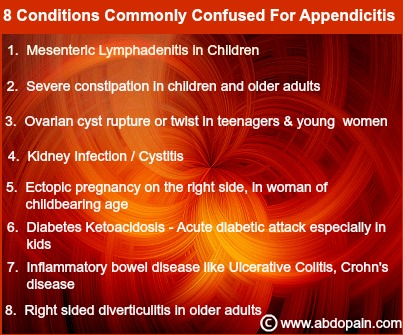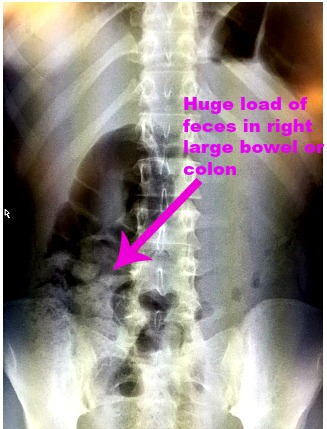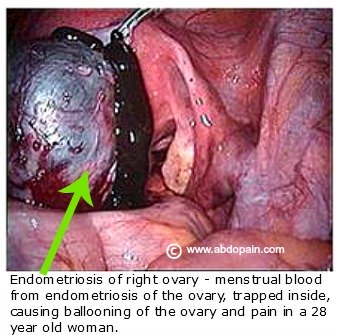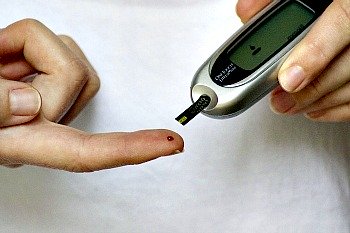Differential Diagnosis of Appendicitis
Top Conditions Commonly Confused For Appendicitis
The differential diagnosis of appendicitis or conditions commonly confused for appendicitis include any illness that could lead to new onset pain on the right lower abdomen, around the spot where the appendix is found. We bring you a comprehensive list of such mimickers of acute appendicitis and how to differentiate them from appendicitis.
Do you or your loved one have pain on the right lower abdomen and wondering if this is appendicitis or not?
Or have you taken your kid to see the doctor and you've been told that his or her pain is not likely due to an acute appendicitis?
Are you asking yourself: "If it is not appendicitis, then what is it"?
Well, there are many conditions that mimics appendicitis. They are referred to as differential diagnosis of appendicitis.
In order to avoid an unnecessary surgical operation on an appendix that may not be inflamed, or even more importantly, not miss the diagnosis of a condition more serious than appendicitis with potential to cause fatality within hours or a few days, it is crucial and extremely important that these "differential diagnosis" or mimickers of appendicitis be considered any time anyone develops signs and symptoms thought to be due to appendicitis.
Yes. A more swiftly fatal but easily remediable medical condition can be missed with ugly results if a consideration is not given to the differential diagnosis of appendicitis. An example no one would like to miss would be an ectopic pregnancy in a young lady presenting with right lower abdominal pain or even diabetic keto-acidosis in a child not previously known to have diabetes.
Let's list the more common conditions that mimic appendicitis and then discuss how to differentiate a few of them from acute appendicitis.
Common Differential Diagnosis of Appendicitis
The common conditions that could be confused with appendicitis are:
- Mesenteric Adenitis
- Constipation
- Urine tract infection
- Kidney infection
- Kidney stones (on the right side)
- Twisted or ruptured ovarian cyst in a young woman or teenager
- Right sided Mid-cycle pain in a teenager within first few years of starting her menstruation
- Ectopic pregnancy
- Food poisoning (or gastroenteritis)
- Inflammatory bowel disease like Crohn's disease or ulcerative colitis
- Acute right sided pelvic inflammatory disease (salpingitis)
- Diabetic ketoacidosis
- Abdominal migraine
- Right sided diverticulitis
- Pulled muscle, right lower abdomen
- Epiploic appendagitis
- Cholecystitis
- Right sided Rectus Sheath Haematoma
- Tumour involving the Cecum
- Tuberculosis of the cecum
- Carcinoid tumour
- Eosinophilic colitis
- Endometriosis involving the right ovary / fallopian tube
- Round ligament pain in second or third trimester of pregnancy.
Let us now discuss the top common ones.
1. Mesenteric Adenitis
This is also called non specific mesenteric lymphadenitis. It is a condition commonly seen in children, though can occur at any age. The lymph nodes or glands on the wall of the small intestines become swollen or inflamed, causing pain in the abdomen.
Mesenteric adenitis usually follow a previous cold or virus infection within or in the preceding two weeks before the onset of the abdominal pain. They might have had a throat infection or still does. If you child has had cough and running nose and running nose or sore throat within the last two weeks or still has it now and then complains of abdominal pain, then it is likely that he or she is having mesenteric lymphadenitis.
Typically, you can differentiate mesenteric adenitis from appendicitis by the following:
Mesenteric Adenitis
- Right sided abdominal pain preceded by history of cough or sore throat in the last two weeks or so
- Pain could start anywhere in the abdomen and moves around and sometimes not even there
- The child with mesenteric adenitis remains hungry and would eat his or her breakfast, lunch or dinner
- The child with mesenteric lyphadenitis tends not to become more unwell as the day passes by. Can still play and run around
- If the appendix gets operated and taken out, the histology reports a normal noninflamed appendix.
Acute Appendicitis
- Right lower abdominal pain that starts off in a previously well child within the last 1 to 3 days
- The pain of acute appendicitis usually starts around the navel or umbilicus and within a day or so, moves to the right lower abdomen and remains there always
- The child with appendicitis typically would not want to eat and may actually vomit or complain of feeling nauseated
- In appendicitis, the pain worsens, and child or suffer progressively gets more unwell in most cases (greater than 90% of the time)
- The histology here would confirm that the appendix is inflamed.
2. Constipation
Constipation is the infrequent passage of stool or passage of hard stools.
It is a very common cause of abdominal pain in children and adults alike. Though it is relatively easy to tell if you are constipated, sometimes, people are constipated without even realizing it.
If you have not opened your bowel as frequently or passed enough feces as much as you normally would, or even if the consistency of your bowel motion has hardened up in the last few days, it is most likely that you are constipated.
Constipation is another condition that is often confused acute appendicitis. Chronic constipation is easily identifiable. Acute constipation could be more subtle to spot.
If you have a huge load of feces sitting inside the lumen of your large bowel, you can imagine the tension it could cause inside by distending the bowel wall and causing abdominal pain.
Constipation could also be a feature or symptom of acute appendicitis.
So, how can you tell if you are having just constipation or if it is a part of the symptom complex of acute appendicitis?
The main difference between pure constipation and constipation occurring with appendicitis or even appendicitis pain is mainly the migratory character of the pain in acute appendicitis and presence of fever.
Let's take a look at the other symptoms of appendicitis vs constipation here.
Appendicitis
- Abdominal pain in appendicitis starts with pain around the umbilicus or upper abdomen and then moves to the right lower abdomen
- Appendicitis is often associated with fever
- There is often loss of appetite with appendicitis
- There could be an episode or two of vomiting with acute appendicitis
- If there is no intervention, acute appendicitis usually progress and deteriorates with patient becoming more unwell within 3 to 5 days.
- Opening your bowel or passing stool does not help resolve the symptoms of acute appendicitis.
Constipation
- Constipation would cause pain in just one spot in the abdomen and unlikely to move within hours or days
- It is unlikely to have fever with constipation
- You can also have loss of appetite with constipation
- In severe constipation, there could also be vomiting associated
- Constipation can go on for many more days or weeks and symptoms usually resolves once stool is passed.
3. Ovarian Cyst
Problems with ovarian cyst are among the top causes of unnecessary surgical operation in young women.
The ovary is where eggs are produced in a women.
Each ovary has thousands of eggs and once every month, usually in turns, they release eggs by a process known as ovulation. This roughly occurs around the middle of a woman's cycle - around two weeks after the last menstrual period.
The released egg leaves behind the sac from from which it is expelled. Sometimes, a woman may bleed into the sac, leading to the formation of cyst filled with blood. This could lead to pain in the abdomen. If this happens on the right side, it could lead to right lower abdominal pain which then mimics an acute appendicitis.
For some reasons, some of such cysts forms an hormone releasing sac or ovarian cyst referred to as corpus luteum cyst. These too could lead to abdominal pain.
As can be seen on the picture here, an ovarian cyst could also become filled with endometriotic collection, distending the cyst significantly, causing right lower abdominal pain.
Another way that an ovarian cyst could cause pain and become a differential diagnosis of appendicitis is it it ruptures or twist on its stalk. This would lead to very sudden severe lower abdominal pain that spreads down to the right hip and upper thigh, as well as lower back, if this is occurring on the right side.
So, how can you differentiate the pain caused by an ovarian cyst vs those caused by acute appendicitis?
Ovarian Cyst
- Pain from a right ruptured or twisted ovarian cyst comes on as a sudden pain, though it could also be felt as a gradual onset pain too, and usually starts from the right lower abdomen
- The pain then spreads to the lower back and upper right thigh in most cases
- There maybe very low grade fever with ovarian cyst, if any fever at all
- Patient could vomit with severe pain from ovarian cyst
- Loss of appetite is very unlikely with ovarian cyst.
Appendicitis
- The pain from acute appendicitis starts from the upper abdomen (epigastrium) or around the umbilicus and then gradually moves over to the right lower abdomen
- Once the pain in acute appendicitis settles on the right lower abdomen, it does not tend to move off from there or spread to other sites
- The is usually associated fever in acute appendicitis,and the temperature could get to 38 degrees Celsius or more
- There could be vomiting here as well
- Loss of appetite is a very frequent association with acute appendicitis.
4. Ectopic Pregnancy
Ectopic pregnancy occurs when a newly formed pregnancy settles anywhere outside the uterus, instead of inside the uterus.
This commonly occurs within the Fallopian tubes. As the fetus grows, the lumen of the tube becomes far too narrow for it, and the tube may rupture, leading to loss of the baby and massive bleeding from the large blood vessels within the tube. Within hours, a woman could loose all her blood volume into the abdominal cavity. Sometimes, the bleeding may be minimal if it is just a crack on the wall of the tube … a leak instead of torrential blood loss.
Such women will come up with sudden onset right sided lower abdominal pain, may vomit, and even have mildly raised temperature, and other signs and symptoms of appendicitis. She may not be aware she is pregnant, since leaking or ruptured ectopic pregnancy usually happens within the first 6 – 8 weeks of pregnancy (just when she realizes that she has missed her period or menses).
Clearly, ectopic pregnancy is a very important differential diagnosis of appendicitis in all women of childbearing age - from age 13 to 59! If you or your young daughter suffers with a right lower abdominal pain, it is important to have a pregnancy test done if there is the slightest chance of pregnancy, to exclude this condition.
The following are differences between appendicitis and ectopic pregnacy:
Ectopic Pregnancy
- Lower abdominal pain, which may be preceded by unexpected vaginal bleed or spotting
- This usually occur associated with a delayed menses or period
- Urine or home pregnancy test would be positive
- There may be increasing vaginal bleeding with the pain
- There may be associated feeling like fainting and shoulder tip pain
Appendicitis
- Lower abdominal pain which often starts around the umbilicus and then moves over to the right lower abdomen
- Appendicitis could occur at any point during the menstrual cycle
- Pregnancy test does not have to be positive
- No vaginal bleeding except if having a normal period or menses
- Shoulder tip pain very unlikely in acute appendicitis
5. Diabetic Ketoacidosis
Diabetic ketoacidosis is a dangerous condition that occurs when the amount of sugar in the blood is too much and the cells are unable to utilize it due to abnormal metabolism seen in people who are diabetic. Their cells instead, start breaking down fat in their liver and under their skin, leading to the production of very large amount of ketones and acid.
It leads to rapid dehydration of the body, abdominal pain, increased rate of breathing, tiredness, vomiting and within 24 hours, many suffers would slump into unconsciousness. It could be rapidly fatal if not diagnosed and treated promptly.
Diabetic ketoacidosis tends to happen in patients with type 1 diabetes.
On many occasions, children have been brought into an emergency room or department with complaints of lower abdominal pain, not eating, very thirsty with fever and initially thought to have acute appendicitis, only to find out during routine testing that it is indeed a case of diabetic ketoacidosis (DKA).
Appendicitis Stories - Have Your Say!
Are you suffering with a right sided abdominal pain? Do you suspect that this might be due to appendicitis? Or have you had your appendix removed? What was your experience like? Share your appendicitis stories here. We would really love to hear from you!







